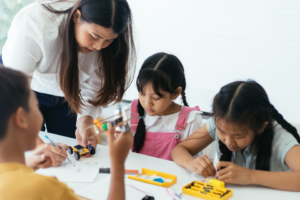
5 Effective Teaching Styles that Should Be Used in All Classrooms

Remember those really great lectures we sat through as students with the teacher at the front of the class behind the podium speaking for what seemed like hours? Me neither. We all have sat through many of these lectures, but none that were so mesmerizing that we still remember it to this day. It really isn’t an effective teaching style, unless maybe it is being done at the college level with adults that have the attention span.
We never liked that as students ourselves, so why should we inflict this pain on to our students now? In the education field, teachers tend to do the same thing year after year, rarely straying from what previous teachers did. Teaching in the 21st century requires a different approach. The classroom has to be more student-centered, but teacher led. The students need to be more actively engaged.
There are five teaching styles listed below that can be incorporated into most lessons. A combination of them all with keep the students actively engaged and on their toes. Plus, students learn differently, so incorporating as many ways to educate them will be to their own benefit.
1. Technology Infused
As a teacher that has taught in classrooms that had some sort of computer device for every student (1:1 technology initiative), nothing has grasped the kids’ attention better than lessons infused with constant technology usage. It is also better preparing them in the long run for a 21st century education because these skills will definitely develop more as they become older.
Every single lesson plan can incorporate technology in it somewhere, whether it is doing research or using corresponding apps. The Google Docs app is being used by numerous districts because it is totally free to use, is quite handy, can be accessed anywhere there is internet, and it automatically saves the students’ work. Plus, using a projector or a SmartBoard will keep the kids’ attention and actively engaged without having a need to even use the textbook.
2. Discussion
Most teachers still seem to teach straight out of the textbook and never stray from it. There is no quicker way to lose a student than reading exclusively out of a textbook that is probably going to be twenty years old. Why do we trust textbook publishers to better know what the students need other than relying on our own instinct?
This is why the discussion method works so well. There will be things covered that are not in the textbooks, but can be found elsewhere. Remember that a discussion means communication between two or more parties. Keep everything teacher led, but know enough when to take a backseat as well.
3. Demonstrations
The demonstration teaching method involves students and/or teacher performing activities and experiments as a way to better understand the concept that is being taught. This gives the students a bit of hands-on learning that works so well with the many different learning styles.
4. Presentations
Students need to be comfortable presenting in front of the class at an early age. It will be so much easier to build off of this skill when they get older. As teachers and parents, we have had to sit through horrible presentations by highly educated adults and colleagues that have left us scratching our heads. How can someone in a leadership position not know how to put on an entertaining presentation without thoroughly boring the audience?
This is where you come in as a quality educator. Not only will you teach the students through educational and entertaining presentations, but you will allow them to frequently put on individual and group presentations of their own. Every classroom has at least a projector, many times some sort of Smart Board like device, that will enable the students to use their technology skills and create quality material through presentation software that they can display to the class. Or go old school and allow them to use poster boards instead. The key is to give them experience with presenting.
5. Collaborative Learning
Collaborative or cooperative learning means that students work in small groups in an effort to solve a problem, study the text, or complete some sort of task assigned by the teacher. This enables the students to share their strengths and better develop the skills they are lacking in.
In the real world outside the classroom, people work together to figure out solutions to problems. Let students have a bit of practice at this while they are still young. It will allow them to learn how to make their voice heard in a group. Learning when it is appropriate to listen or lead is something everyone struggles with. Collaborative learning will provide the practice needed to develop these talents.
Written by Ryan Crawley
Contact us today to learn more about how our Professional Development presentations and workshops can benefit your school and staff!



